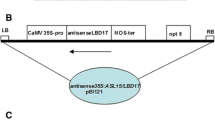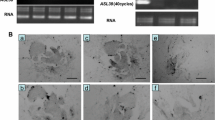Abstract
ASYMMETRIC LEAVES2-LIKE11 gene of Arabidopsis is a member of the ArabidopsisASYMMETRIC LEAVES2 (AS2)/LATERAL ORGAN BOUNDARIES (LOB) domain gene family. With the exception of ASYMMETRIC LEAVES2 (as2), mutants of AS2/LOB family genes reported so far have not displayed any obvious phenotypes. Therefore, the effects of mutant asl11 are most likely masked by functional redundancy. To elucidate the role of ASL11 gene in plant growth and development, we introduced 35S:ASL11 to Arabidopsis plants via Agrobacterium tumefaciens. Data suggest that the observed phenotypes might be caused by misexpression of KNOX genes triggered by 35S:ASL11. However, it is possible that these phenotypes might be generated by an artifact due to the effect of the production of ASL11 RNAs, which might affect expression of unidentified members of the AS2/LOB family, which includes 42 members and other unknown genes. The cockscomb transformation systems that we have established facilitate the use of this species for studies on gene manipulation and expression. Therefore, here, we extend our studies to include additional transformants; namely, we report transformation of ASL11 gene to cockscomb plants. A total of 46 T1 35S:ASL11 plants were identified by polymerase chain reaction (PCR), confirmed by assay of ASL11-GFP fusion proteins. The leaves of some 35S:ASL11 plants (13/46) showed lobed or rumpled patterns. Shoot apical meristems of some 35S:ASL11 plants (18/46) displayed pin-like structures that lacked organ primordial. Data suggest that these malformed phenotypes might be triggered by ectopic expression of KNOX genes caused by 35S:ASL11. In general, all data indicate that ASL11, a transcription factor, might be involved in regulating KNOX gene expression in plant development.






Similar content being viewed by others
References
Aida M, Tasaka M (2006) Morphogenesis and patterning at the organ boundaries in the higher plant shoot apex. Plant Mol Biol 60:915–928
Borghi L, Bureau M, Simon R (2007) Arabidopsis JAGGED LATERAL ORGANS is expressed in boundaries and coordinates KNOX and PIN activity. Plant Cell 19:1795–1808
Bowman J, Eshed Y (2000) Formation and maintenance of the shoot special meristem. Trends Plant Sci 5:110–115
Byrne ME, Barley R, Curtis M, Arroyo JM, Dunham M, Hudson A, Martienssen RA (2000) ASYMMETRIC LEAVES1 mediates leaf patterning and stem cell function in Arabidopsis. Nature 408:967–971
Byrne ME, Simorowski J, Martienssen RA (2002) ASYMMETRIC LEAVES1 reveals KNOX gene redundancy in Arabidopsis. Development 129:1957–1965
Chalfun-Junior A, Franken J, Mes JJ, Marsch-Martinez N, Pereira A, Angenent GC (2005) ASYMMETRIC LEAVES2- LIKE1 gene, a member of the AS2/LOB family, controls proximaldistal patterning in Arabidopsis petals. Plant Mol Biol 57:559–575
Chuck G, Lincoln C, Hake S (1996) KNAT1 induces lobed leaves with ectopic meristems when overexpressed in Arabidopsis. Plant Cell 8:1277–1289
Endo T, Shimada T, Fujii H, Kobayashi Y, Araki T, Omura M (2005) Ectopic expression of an FT homolog from Citrus confers an early flowering phenotype on trifoliate orange (Poncirus trifoliata L. Raf.). Transgenic Res 14:703–712
Ha CM, Jun JH, Nam HG, Fletcher JC (2007) BLADE-ON-PETIOLE1 and 2 control Arabidopsis lateral organ fate through regulation of LOB domain and adaxial–abaxial polarity genes. Plant Cell 19:1809–1825
Husbands A, Bell EM, Shuai B, Smith HMS, Springer PS (2007) LATERAL ORGAN BOUNDARIES defines a new family of DNA-binding transcription factors and can interact with specific bHLH proteins. Nucleic Acids Res 35:6663–6671
Inukai Y, Sakamoto T, Ueguchi-Tanaka M, Shibata Y, Gomi K, Umemura I, Hasegawa Y, Ashikari M, Kitano H, Matsuoka M (2005) Crown rootless1, which is essential for crown root formation in rice, is a target of an AUXIN RESPONSE FACTOR in auxin signaling. Plant Cell 17:1387–1396
Iwakawa H, Ueno Y, Semiarti E, Onouchi H, Kojima S, Tsukaya H, Hasebe M, Soma T, Ikezaki M, Machida C, Machida Y (2002) The ASYMMETRIC LEAVES2 gene of Arabidopsis thaliana, required for formation of a symmetric flat lamina, encodes a member of a novel family of proteins characterized by cysteine repeats and a leucine zipper. Plant Cell Physiol 43:467–478
Iwakawa H, Iwasaki M, Kojima S, Ueno Y, Soma T, Tanaka H, Semiarti E, Machida Y, Machida C (2007) Expression of the ASYMMETRIC LEAVES2 gene in the adaxial domain of Arabidopsis leaves represses cell proliferation in this domain and is critical for the development of properly expanded leaves. Plant J 51:173–184
Kardailsky I, Shukla VK, Ahn JH, Dagenais N, Christensen SK, Nguyen JT, Chory J, Harrison MJ, Weigel D (1999) Activation tagging of the floral inducer FT. Science 286:1962–1965
Kobayashi Y, Kaya H, Goto K, Iwabuchi M, Araki T (1999) A pair of related genes with antagonistic roles in mediating flowering signals. Science 286:1960–1962
Kojima S, Takahashi Y, Kobayashi Y, Monna L, Sasaki T, Araki T, Yano M (2002) Hd3a, a rice ortholog of the Arabidopsis FT gene, promotes transition to flowering downstream of Hd1 under short-day conditions. Plant Cell Physiol 43:1096–1105
Lin WC, Shuai B, Springer PS (2003) The Arabidopsis LATERAL ORGAN BOUNDARIES-domain gene ASYMMETRIC LEAVES2 functions in the repression of KNOX gene expression and in adaxial–abaxial patterning. Plant Cell 15:2241–2252
Long JA, Moan EI, Medford JI, Barton MK (1996) A member of the KNOTTED class of homeodomain proteins encoded by the SHOOTMERISTEMLESS gene of Arabidopsis. Nature 379:66–69
Meng LS, Ding WQ, Hu X, Wang CY (2009a) Transformation of PttKN1 gene to cockscomb. Acta Physiol Plant 31:683–691
Meng LS, Song JP, Sun SB, Wang CY (2009b) The ectopic expression of PttKN1 gene causes pleiotropic alternation of morphology in transgenic carnation (Dianthus caryophyllus L.). Acta Physiol Plant 31:1155–1164
Meng LS, Liu HL, Cui XH, Sun XD, Zhu J (2009c) ASYMMETRIC LEAVES2-LIKE38 gene, a member of AS2/LOB Family of Arabidopsis, causes leaf dorsoventral alternation in transgenic cockscomb plants. Acta Physiol Plant 31:1301–1306
Naito T, Yamashino T, Kiba T, Koizumi N, Kojima M, Sakakibara H, Mizuno T (2007) A link between cytokinin and ASL9(ASYMMETRIC LEAVES 2 LIKE 9) that belongs to the AS2/LOB (LATERAL ORGAN BOUNDARIES) family genes in Arabidopsis thaliana. Biosci Biotechnol Biochem 71:1269–1278
Nakazawa M, Ichikawa T, Ishikawa A, Kobayashi H, Tsuhara Y, Kawashima M, Suzuki K, Muto S, Matsui M (2003) Activation tagging, a novel tool to dissect the functions of a gene family. Plant J 34:741–750
Okushima Y, Fukaki H, Onoda M, Theologis A, Tasaka M (2007) ARF7 and ARF19 regulate lateral root formation via direct activation of LBD/ASL genes in Arabidopsis. Plant Cell 19:118–130
Ori N, Eshed Y, Chuck G, Bowman JL, Hake S (2000) Mechanisms that control KNOX gene expression in the Arabidopsis shoot. Development 127:5523–5532
Pena L, Martin-Trillo M, Juarez J, Pina JA, Navarro L, Martinez-Zapater JM (2001) Constitutive expression of Arabidopsis LEAFY or APETALA1 genes in citrus reduces their generation time. Nat Biotechnol 19:263–267
Rosin FM, Hart JK, Horner HT, Davies PJ, Hannapel DJ (2003) Overexpression of a knotted-like homeobox gene of potato alters vegetative development by decreasing gibberellin accumulation. Plant Physiol 132:106–117
Schneeberger R, Tsiantis M, Freeling M, Langdale JA (1998) The ROUGH SHEATH2 gene negatively regulates homeobox gene expression during maize leaf development. Development 125:2857–2865
Semiarti E, Ueno Y, Tsukaya H, Iwakawa H, Machida C, Machida Y (2001) The ASYMMETRIC LEAVES2 gene of Arabidopsis thaliana regulates formation of a symmetric lamina, establishment of venation and repression of meristem-related homeobox genes in leaves. Development 128:1771–1783
Shuai B, Reynaga-Peña CG, Springer PS (2002) The LATERAL ORGAN BOUNDARIES gene defines a novel, plant-specific gene family. Plant Physiol 129:747–761
Sinha NR, Williams RE, Hake S (1993) Overexpression of the maize homeobox gene, KNOTTED-1, causes a switch from determinate to indeterminate cell fates. Genes Dev 7:787–795
Timmermans MCP, Hudson A, Becraft PW, Nelson T (1999) ROUGH SHEATH2: a myb protein that represses KNOX homeobox genes in maize lateral organ primordia. Science 284:151–153
Tsiantis M, Schneeberger R, Golz JF, Freeling M, Langdale JA (1999) The maize ROUGH SHEATH2 gene and leaf development programs in monocot and dicot plants. Science 284:154–156
Ueno Y, Ishikawa T, Watanabe K, Terakura S, Iwakaw H, Okada K, Machida C, Machidaa Y (2007) Histone deacetylases and ASYMMETRIC LEAVES2 are involved in the establishment of polarity in leaves of Arabidopsis. Plant Cell 19:445–457
Volbrecht E, Reiser L, Hake S (2000) Shoot meristem size is dependent on inbred background and presence of the maize homeobox gene. Development 127:3161–3172
Waites R, Selvadurai HRN, Oliver IR, Hudson A (1998) The PHANTASTICA gene encodes a MYB transcription factor involved in growth and dorsoventrality of lateral organs in Antirrhinum. Cell 93:779–789
Xu L, Xu Y, Dong A, Sun Y, Pi L, Xu Y, Huang H (2003) Novel as1 and as2 defects in leaf adaxial–abaxial polarity reveal the requirement for ASYMMETRIC LEAVES1 and 2 and ERECTA functions in specifying adaxial identity. Development 130:4097–4107
Acknowledgments
This research was supported by the Natural Science Foundation of China (Grant No. 30970169).
Author information
Authors and Affiliations
Corresponding authors
Rights and permissions
About this article
Cite this article
Sun, XD., Meng, LS., Feng, ZH. et al. ASYMMETRIC LEAVES2-LIKE11 gene, a member of the AS2/LOB family of Arabidopsis, causes pleiotropic alteration in transgenic cockscomb (Celosia cristata). Plant Cell Tiss Organ Cult 101, 193–200 (2010). https://doi.org/10.1007/s11240-010-9676-x
Received:
Accepted:
Published:
Issue Date:
DOI: https://doi.org/10.1007/s11240-010-9676-x




